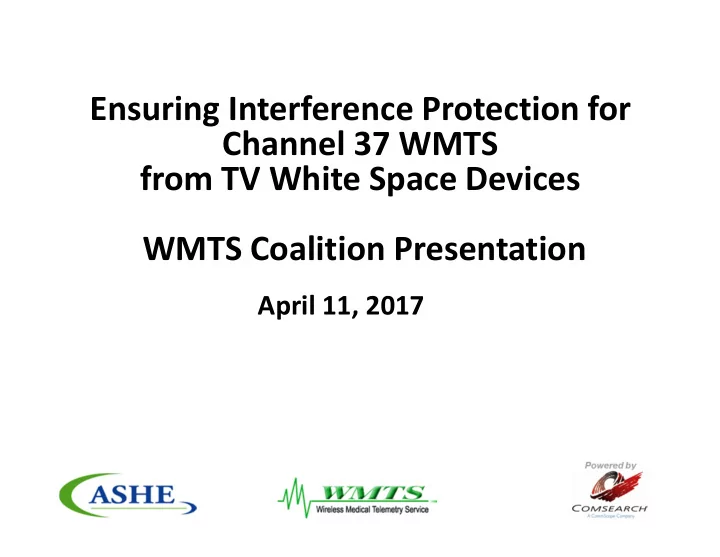

Ensuring Interference Protection for Channel 37 WMTS from TV White Space Devices WMTS Coalition Presentation April 11, 2017
Overview • To ensure patient safety, FCC should correct technical errors and omissions in Part 15 Report and Order to provide sufficient separation distances between TVWS devices and WMTS – Separation distances should be approximately 3 times those adopted (as set forth in WMTS Coalition and GEHC Reconsideration Petitions) – The dependability of the WSDB – including the reliability and integrity of device-resident software – must be assured • Costly and resource intensive waivers can be avoided if separation distances are properly adopted • Sufficient testing must be done before the widespread deployment of TVWS devices in Channel 37 • Burden of ensuring interference protection should be on unlicensed TVWS operators, not licensed WMTS 2
Patient Safety Depends on Effectively Functioning WMTS in Channel 37 • More hospitals use Channel 37 for WMTS than either 1.4 GHz band – 608-614 MHz (2,672 hospitals) – 1395-1400 MHz (1,964 hospitals) – 1427-1432 MHz (1,891 hospitals) • WMTS used daily by hospitals who have invested significantly in technology that is not easily or regularly replaced • Primary use cases include: – Cardiac monitoring (adults and children) – Fetal monitoring (608-614 MHz is the only band currently being used for this purpose) – Monitoring vital signs of critically ill patients and other patients who are ambulating 3
FCC Should Correct Technical Issues To Provide Sufficient Protection Distances • Apply interference-to-noise ratio (I/N) of -6 dB to the receiver sensitivity rather than receiver noise floor • Use minimum required Signal to Noise Ratio (SNR) of approximately 10 dB • Use height above ground level (HAGL) of a fixed TVWS device, rather than height above average terrain (HAAT) – Limit height of a fixed TVWS device to numerical value that results in the shorter distance above ground level of either the antenna’s HAAT or the antenna’s HAGL 4
FCC Should Correct Technical Issues To Provide Sufficient Protection Distances • Revisit assumption that a WMTS receiver would be at height of 10 meters above ground level – More than half of Channel 37 hospitals have deployments 10 meters above ground level; a more appropriate assumption is 20-22 meters • TM 91-1 propagation model should be reconsidered because it will not reflect a realistic assessment of a hospital’s most vulnerable areas • Rules should include an aggregation factor of at least 6 dB to account for aggregating signals being received from multiple sources and the potential for an interfering signal radiating into more than one WMTS antenna 5
FCC Must Address Omissions Regarding WSDB Dependability • The Whitespace Database System (WSDB), which contains both the databases and TVWS device-resident software, is the lynchpin for ensuring protection distances are enforced • R&O declared in a footnote that the rules are “adequate to ensure security of the white space access systems” but failed to address any of the specific concerns raised in the proceeding • Secure and reliable databases alone are not sufficient – The dependability ( i.e ., security, integrity and reliability) of device-resident WSDB software must also be ensured – Rules and certification procedures contain no mechanisms to ensure the dependability of TVWS device-resident software – Current device certification regime has already allowed devices that violate existing TVWS device security rules to reach the market and corrupt the integrity of the information in the databases 6
TVWS Operators Bear the Burden of Preventing Interference to Licensed WMTS TVWS operation on Channel 37 should not be able to commence in • any market until: – Trials are conducted and successfully completed in at least two locations under the oversight of an Institutional Review Board – A method has been developed to promptly resolve any interference that occurs to a WMTS system TVWS operation on Channel 37 should not be able to commence in • a particular market until: – TVWS operators seeking to operate on Channel 37 have ensured that each hospital in the market using Channel 37 WMTS has its perimeter accurately registered in the TVWS database – If necessary, TVWS operator should be financially responsible for any required mapping and registration (subject to oversight by the hospital) 7
Only Fixed TVWS Devices Should Be Allowed To Operate in Channel 37 Initially • The FCC should “walk before it runs” in considering which TVWS devices should be allowed to share Channel 37 with WMTS patients – Fixed devices should initially be authorized at conservatively determined distances – Personal/Portable devices should not be authorized until industry has real-world experience with the geolocation technology on other channels 8
Contact Information Tim Adams Director of Member Professional Development American Society for Healthcare Engineering tadams@aha.org 9
Recommend
More recommend